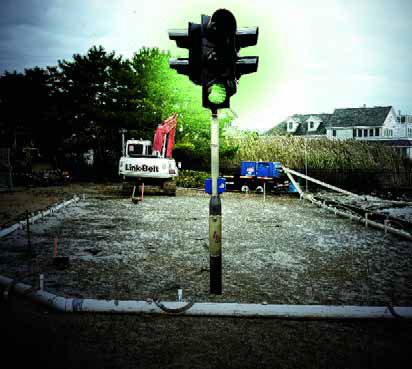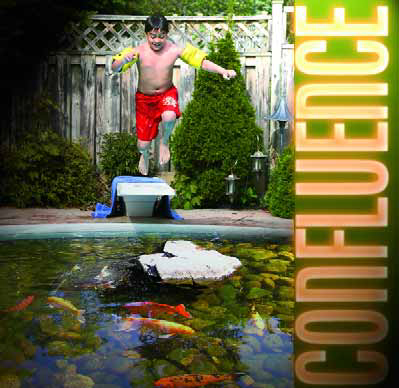WaterShapes
Working as a watershape designer, I'm always a little bit taken aback when people come up to me and say they're so amazed by the work I do and that they know they could never do anything so creative themselves. It's all part of a common perception that so-called "creative" work is produced only by people who were born with a particular talent. Frankly, I don't agree with that perception. As I look back over my career and review the work of others, it's clear to me that creativity in design (or anything else, for that matter) is essentially a muscle we all can develop. Sure, some people have natural abilities that give them a boost, but the essence of creativity has more to do with the way you go about pursuing it than anything else. Along those lines, I recently finished reading Cracking Creativity: The Secrets of Creative Genius by Michael Michalko (Ten Speed Press, 2001). This terrific, 300-page book tackles the nature of
In the design and construction of any watershape, there are a number of points in the process where you can see big differences between the way custom designers and contractors do things and the way production/volume-oriented companies go about their business. From first conversations with clients straight through to commissioning the system and turning it over to the homeowners, it's easy to spot these distinctions and define key differences. To illustrate just one of these areas, let me discuss the case of the permitting phase for the project on Long Beach Island, N.J., I began covering two issues ago. What's involved here is a cluster of issues that occurred more or less simultaneously in the project's early going. The elements of this cluster may not seem directly related to one another, but
Although my practice primarily encompasses residential landscapes, I occasionally tackle a commercial project. In one such case, I was recently asked to design the entry planting and make recommendations for the hardscape at the Riviera Country Club in Pacific Palisades, Calif. One of the most prestigious golf courses in the world, Riviera is the regular host to the Nissan Open, one of the sport's premier tournaments. It's a high-profile site in every conceivable way, so image is everything to the facility's owner and managers. After many years of placing what were essentially band-aids on the entry's landscape, they decided it was time for a complete overhaul and a
It might be something of a cliché, but it's often said that there's great wisdom in being willing and able to learn the lessons of history. In that spirit, I recently took advantage of an opportunity to sit in on a class in the
In most projects, great work requires the watershaper's personal understanding of who the clients really are, deep down. That doesn't mean we have to become our clients' best friends or marry into their families. Rather, creating watershapes at the highest level involves a different kind of relationship, one in which a shared vocabulary and common vision develop through discussions of water, stone, art, plants and the orchestration and staging of experiences that will occur in given spaces. Take the project covered here as an example: The scope of the work, an unlimited budget and a mandate for the highest possible levels of quality were enough on their own to force us to explore the limits of our skills and creativity. More important from our perspective, however, is that we
The shopping mall as we know it first emerged in the United States in the 1960s and since then has become a dominating retail presence on both the urban and suburban scenes. They started out in larger cities but soon were found just about everywhere - indoors or outdoors, small and large, visually appealing and, well, less visually appealing. Some are organized around upscale shopping and recreational activities, others around discount centers and manufacturers' outlets. There are many that are filled with mom-and-pop boutiques, while a few are integrated with amusement parks. Whatever seems likely to succeed, mall developers have certainly been willing to give it a whirl. At their core, however, every mall of any type has the primary mission of pulling people together so they can spend money on all kinds of merchandise; all the entertainment, dining and socializing are, in other words, secondary activities. In this sense, today's retail forums are a modern version of marketplace traditions that reach back to ancient times and almost every human society - with lots of modern conveniences added for good measure. Today's malls, in fact, are
The history of residential architecture took a real turn toward mass production with the emergence of the modern suburb early in the 20th Century. Especially in the years after World War II, middleclass families increasingly left urban congestion behind and headed for open outlying areas where developers were hard at work in preparation for their arrival. Some developers put distinct stylistic stamps on the neighborhoods and communities they were building. Among the most popular and recognizable of these styles was the Spanish Colonial Revival - a look that has special prominence on the West Coast but that has surfaced throughout the United States and in places as far flung as Europe and China. This style is so popular and has been used so much in so many variations that it is, these days, tough to nail down exactly what is or is not true to early Spanish Colonial motifs and ideas. That's not surprising, because this malleable style itself represents a cobbling together of ideas borrowed from Roman, Islamic and even Native American cultures. Those deep roots, coupled with a scattering of design focus that has blurred borders and distinctions and any sense of stylistic purity, makes it tough for 21st-century watershapers and other designers to
I recently had the pleasure of taking a brief trip to Costa Rica. Beyond a little sightseeing and some rest and relaxation, my purpose was to consult with watershaper Juan Roca to determine the feasibility of creating planting plans to complement his incredible watershapes. I always do my homework when I travel to an unfamiliar area for business purposes, learning as much as I can ahead of time about local vegetation and climate. As a rule, I contact nurseries, check inventories, inquire about the possibilities of bringing in plants the nurseries may not already carry and in general try to figure out
I've been using the word "confluence" a lot lately - so often, in fact, that I decided to look it up to be sure that I wasn't misusing it in some way. According to Webster, the first definition of confluence is "a flowing together of two or more streams," with a second meaning of "a gathering, flowing, or meeting together at one juncture or point." To me, it's a perfect word to describe a trend that's redefining the watershaping industries - that is, a growing confluence between the pool/spa and pond/stream industries. Coming from the pool/spa side of the discussion, I can recall a time not very long ago when ponds and streams were only rarely if ever considered by anyone in my business. What could pools and spas possibly have in common with






















